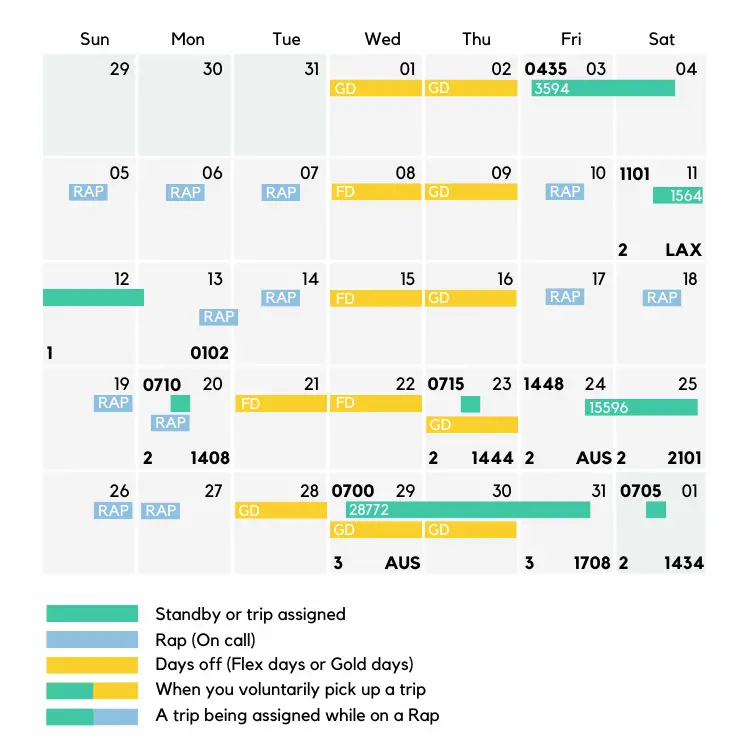No matter what airline you work for, the work schedules of flight attendants tend to be complex, irregular, and kind of hard to understand if you don’t happen to jet set for a living. It can be hard to keep up with our schedules to know when we might have time to spend with friends and family, or even schedule a simple doctor’s appointment. The same is, of course, true for American Airlines as well.
Even learning how to read a schedule is challenging since the information provided is usually presented in a mix of industry terminology and acronyms that tend to vary from airline to airline.
As a former American Airlines flight attendant, I will walk you through what our schedules are like in the simplest terms possible.
So, if you are thinking of becoming an AA Stew, or if you happen to know and love someone who flies for American, this article will help you better understand the ins-and-outs of our scheduling systems.
What Information Is Included on an American Airlines Schedule?
There are two basic types of schedules at American, and to keep things easy to understand I will separate them.
The first type is a reserve schedule, and the second type is called “a line.”
Both of these schedules are managed through a system at American Airlines called “Crew Portal.”
Information on a Reserve Schedule at American
Being on reserve is to be on call.
So, the schedule is usually arranged which days you will be on-call and which days you have off.
When the schedules are first posted they look like a calendar with nothing on it but the dates you’ll be “on” and the dates you’ll be “off.”
⭐ At American you are guaranteed 12 days off.
There are two different types of days off:
1) Flex Days
These are days you are supposed to have off, but, if need be, the company can extend you into them if a trip they assigned you while on call runs long for some reason.
Generally speaking, if the company “takes” one of your flex days they have to give it back to you later in the month. So that you still end up with the same number of days off.
2) Golden Days
These are days you definitely have off.
The company cannot touch them.
As the month progresses, however, more information will be added to your schedule. This is because American organizes reserve around a daily Preferential Bidding System (PBS) that allows folks on reserve a little bit of control over their lives.
They can, for example, bid to be on a specific on-call shift, known as a “RAP” (Reserve Availability Period), bid for a specific standby shift, or bid for a specific trip that is in “open time.”
📝 Side note: Let me quickly define “open time” to be clear. “Open time” are the trips that need to be filled by a new flight attendant. These are trips that have lost a crew member for whatever reason (sick call, issues with crew legalities, staffing allocation issues, etc.).
They can be filled by either reserve flight attendants, or non-reserve flight attendants looking to pick up extra trips. So, reserves may need to “compete” with more senior flight attendants for the best trips in open time.
As a reserve flight attendant receives assignments, either RAPs, Standby shifts, or trips, the information for those assignments will populate into their schedule online.
Thus, as the month progresses their schedule will start to look more similar to the schedule of a flight attendant who has a line.
The RAPs and Standby shifts merely list the start and end time of these shifts, whereas trips will list all the same information that is listed in the sequence information provided to a line holder. (Explained below).
Information on a Line Schedule at American
If you are holding a line at American Airlines, your schedule will be delivered to you looking like a calendar with green lines crossed through some of the days.
Those green lines indicate the specific trips you will be flying, while blank cells in the calendar indicate your days off.
The portal usually also displays your total scheduled hours for the month.
The information provided will include:
- The sequence numbers of the trips you have been assigned
- The days you will be gone
- The individual legs flown on each sequence
- The location of your layovers for each day you’re on a trip
- The name of the hotel you will stay at
- Information about your shuttle at your layover location
- The names and employee numbers of the other crew members you will fly with
- All information about the pay you will receive
- The specific position you will be working on the trip
Note: Reserves will see this information pop up in their schedule after they are assigned a specific trip.
In other words, you have all the information you could possibly need at your fingertips within Crew Portal.

Schedule While on Reserve at American Airlines
At American, you will serve 19 days on-call for every 31-day calendar month.
During those 19 days you can be assigned any kind of trip possible, from an all-nighter called an ODAN (on duty all night), to an international trip with a nice layover.
It’s hard to give an example of a schedule on reserve because no two months on reserve will ever be the same. There is only one certainty while on reserve at American, you will always serve Standby at least twice.
This is because contractually, each flight attendant must serve Standby before another flight attendant can be assigned a third Standby shift.
Personally, my reserve months were a mix of trips to Germany, because I was a qualified German interpreter (known as a “Speaker”) and ODANs or transcontinental Red-Eyes. During the Pandemic when international flying wasn’t happening, my reserve months were filled with turns and intense 4-day trips with multiple legs each day.
Definition time: A “turn” is a single day trip that involves flying to a city, turning around, and flying home.
For more general information about being on reserve, I recommend reading our article: What Is It Like Being on Reserve for Flight Attendants?
Schedule of a Senior Flight Attendant at American Airlines
Senior flight attendants will almost always hold a line. (Though American’s rotating reserve system does have the tendency to reach up to 30 years of seniority at times.)
They also almost always get the first pick of the best trips, allowing them to easily build schedules to their individual preferences.
That said, most senior flight attendants at American tend to fly “low time,” which is considered flying less than 70 hours a month, and they mostly only work international trips which are usually worth about 18 hours of flight credit per trip. This means they only fly about 3-4 trips a month and tend to only be gone about 12 days a month.
There are of course exceptions to this, I have worked with senior flight attendants who fly high time, or only enjoy flying domestically.
Frequently Asked Questions
Having gone over the basics of Reserve, Lines, and reading a schedule at AA, I will now try to answer some of the most frequently asked questions that tend to come up when I’m talking to folks outside the airline industry.
When do American Airlines flight attendants receive their schedule?
Generally, the schedule is received about two weeks prior to the start of the next “bid month.” Usually, the company will announce that “bids are out” and we’ll all try to log in and see what we have for the next month. It’s an event for us.
How long is the bidding system open?
Bids are usually open for 10 days. Most flight attendants, however, have what is known as a “standing bid” it’s a preset bid in case they miss the bidding window, which prevents them from getting a bottom-of-the-barrel schedule.
Do you usually get what you bid for?
Yes and no. There are seven bidding “layers” in the American bidding system. You enter bids in each layer, as a ranking system, layer 1 is what you want most, and layer 7 is what you can live with.
If you are realistic about what you can get at your seniority, you will usually get awards taken out of layers 1-4.
If you aim a little too high, you can be awarded from lower layers, or from “layer 0” which means you didn’t get anything you wanted, and the company just assigned you leftovers. This usually only happens to the super junior, though.
How many hours do you fly?
The minimum number of hours to keep your FAA qualifications is 40 hours per month. There is no specific maximum, but you do have to take the required number of days off, for FAA requirements, so it is hard to fly much more than about 130 hours a month.
Most flight attendants fly between 70 and 90 hours a month. I used to fly 90-120 hours a month. This is considered very high time.
Is it easy to commute?
It depends on where you are communing from/to. Some are easy, others are not. Commuting is not for the faint of heart. But the nice thing is we have commuting agreements with Delta and United through ID90 at American, which can make it easier for us than for FAs at other airlines that don’t have these agreements.
How is the work-life balance at American Airlines?
It is what you make it. If you fly high time, you won’t have a very good work-life balance. If you fly the bare minimum, you will.
That said, pandemic-era and post-pandemic-era flying has not been a walk in the park. Short staffing has led to a lot of special waivers that allow the company to work flight attendants more than they usually would be contractually allowed to require. But this is not unique to American.
Wrap Up: No Two Schedules Look the Same
In the end, here’s the thing about flight attendants’ schedules. Because American Airlines uses a Preferential Bidding System that allows flight attendants to pick and choose individual sequences, no two schedules will look the same, and each schedule is completely customizable within the constraints of each flight attendant’s seniority.
So, it is hard to capture an “average” schedule in a blog post.
If anything, your takeaway from this article should be “anything is possible, the sky is literally the limit.”
I hope this article made it a little easier to understand what it is like to be a flight attendant at American Airlines.




